TL;DR: Module Federation allows loading Micro Frontends at runtime. Common dependencies like Angular or the Auth0 library can be shared and hence don't need to be loaded several times. This is also the key for sharing data like the current user or global filters.
Micro Frontends
Recently, there have been a lot of discussions about Micro Frontends. The underlying idea is quite tempting: Splitting a huge software system into smaller parts and assigning each part to an individual team:
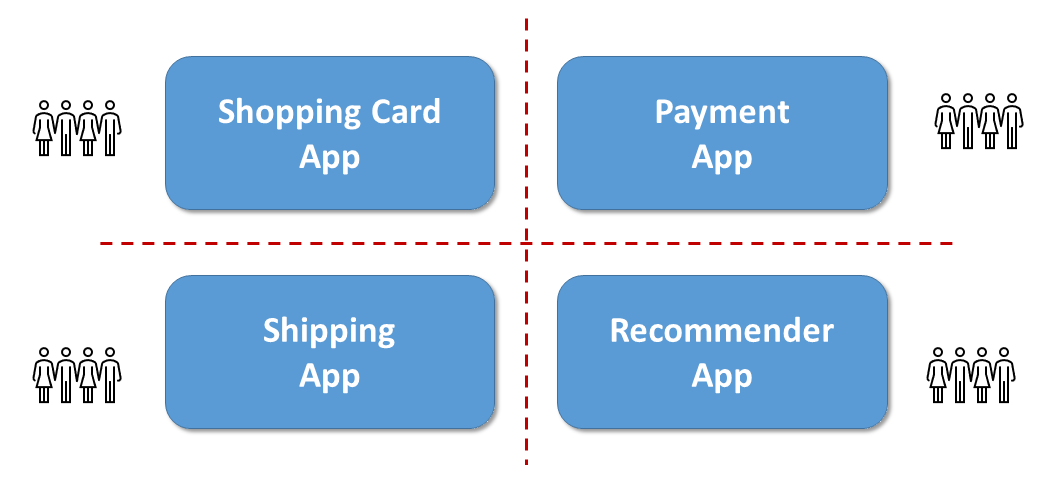
As these teams are -- more or less -- autonomous, they can work in a more flexible way and don't need to coordinate that much with others. This shows that Micro Frontends are mostly about scaling teams. Hence, if you don't have several frontend teams, Micro Frontends might be overkill.
Module Federation
Splitting software systems into several parts is, however, only one side of the coin. Even though we developers might like this idea, the users don't! They aren't interested in starting several frontends but expect an integrated solution.
Accordingly, we need to find a way to make all our micro frontends appear as one (single page) application. Very often, this involves loading micro frontends into a shell application.
For instance, the example used here mimics a simple shopping system. One of its micro frontends deals with shipping:
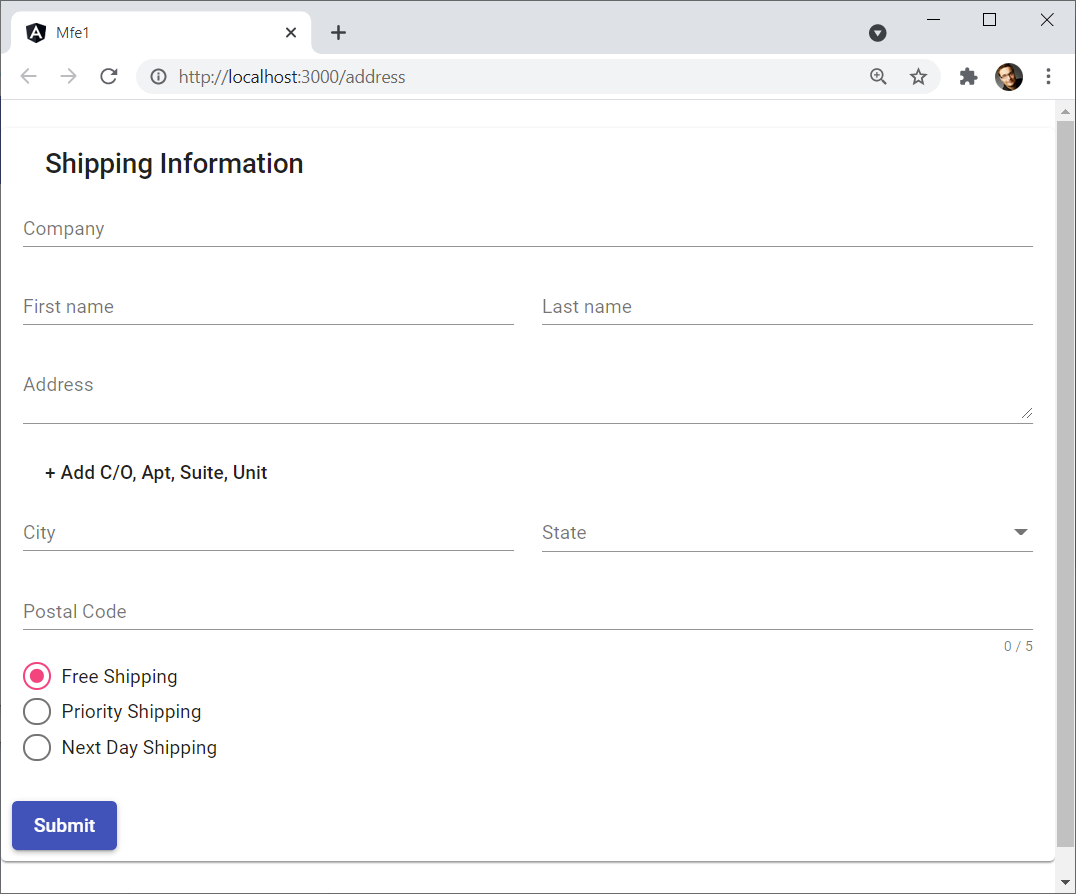
For the purpose of integration, this micro frontend needs to be loaded into a shell:
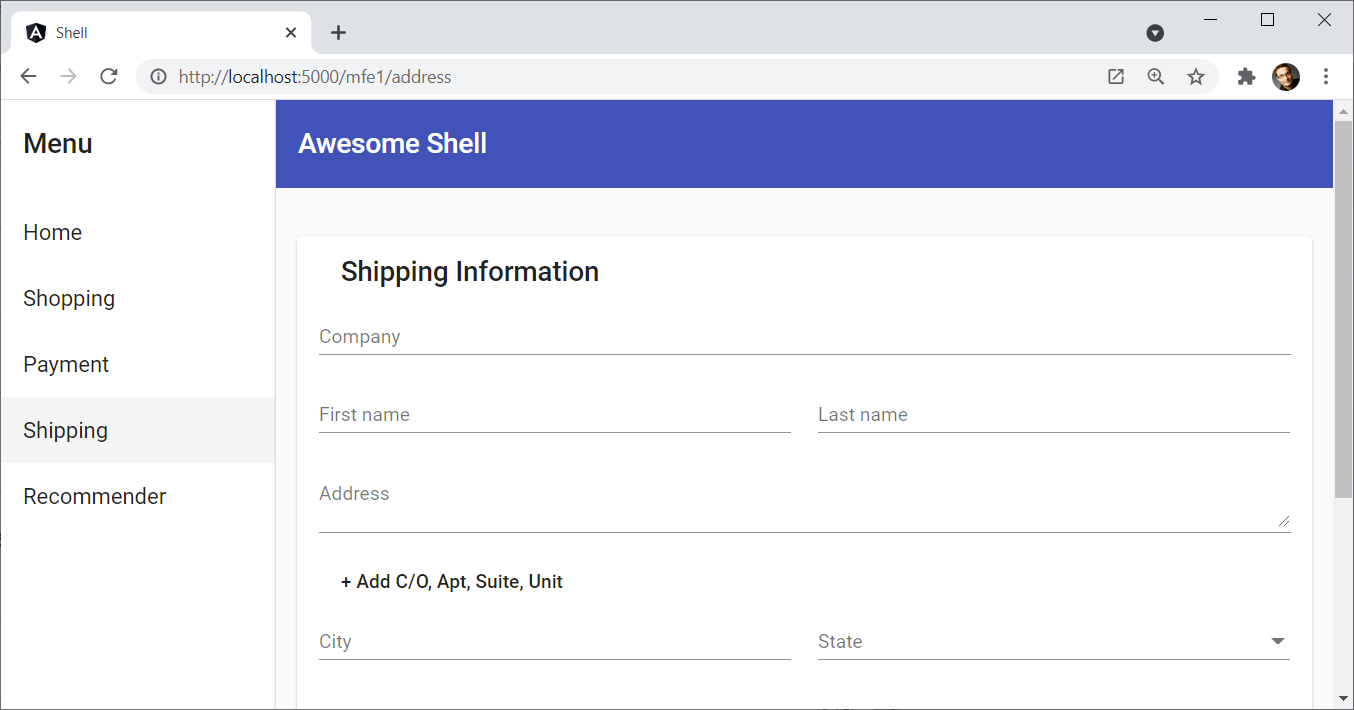
The shell loads this but also other micro frontends on demand.
For such an implementation, you needed a lot of tricks in the past. Fortunately, Module Federation makes this task straightforward.
Module Federation is an integrated part of webpack 5, and hence, it works with all modern web frameworks. Also, as webpack is highly used in nearly all communities, Module Federation immediately becomes a widespread solution.
In order to allow loading separately compiled and deployed micro frontends, Module Federation defines two roles: the host and the remote:
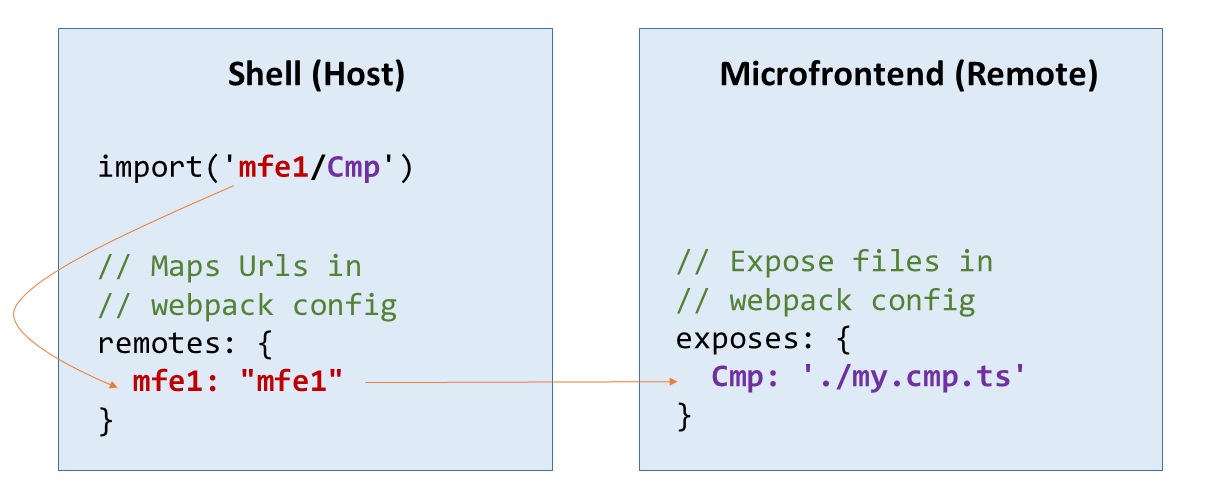
In our case, the host is the shell, while the remote is the micro frontend. Both can be configured with their webpack configurations.
The host defines virtual URLs pointing to remotes. In the previous picture, for instance, the URL
mfe1mfe1The remote, in turn, exposes files -- or, to be more precise: EcmaScript modules -- for the host. To prevent that, the latter one needs to know the remote's file structure; exposed files can get a shorter alias. The example in the last picture goes with the alias
CmpExposed EcmaScript modules can easily be loaded into the host by using a dynamic
importAs Angular doesn't even recognize that the application loads a micro frontend, we can use it exactly as it was intended to be used. We don't need any tricks or meta frameworks orchestrating different SPAs in our browser window. This eases our endeavor dramatically.
Module Federation in Angular
Since version 12, the Angular CLI uses webpack 5. Hence, we also get Module Federation out of the box. To activate it, we need a custom builder that, e. g. ships with the community solution
@angular-architects/module-federationng addng add @angular-architects/module-federation
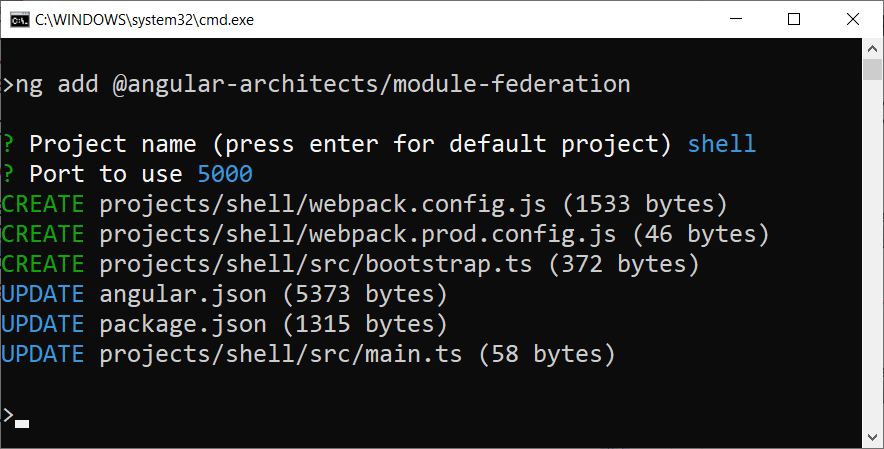
The well-known CLI extension Nx is supported too. The schematic asks about the name of the project in your workspace you want to enable module federation for. Also, it asks which port to assign for
ng serveAfter that, it generates several files, e. g. a partial webpack configuration we need to adjust for our needs. Also, it registers the custom builder in our
angular.jsonFor the example used here, I ran this command twice: Once for the shell and once for the above-shown shipping micro frontend. The latter one is just called
mfe1Configuring the Micro Frontends
Now, we need to adjust the webpack configurations generated for the shell and the micro frontend. As the Angular CLI is generating most parts of the webpack configuration, we just need to define the remaining details for the module federation. First and foremost, this is about configuring the
ModuleFederationPluginLet's start with the configuration for the micro frontend:
// projects/mfe1/webpack.config.js [...] plugins: [ new ModuleFederationPlugin({ // For remotes (please adjust) name: "mfe1", filename: "remoteEntry.js", exposes: { './AddressModule': './projects/mfe1/src/app/address/address.module.ts', }, shared: share({ "@angular/core": { singleton: true, strictVersion: true, requiredVersion: 'auto' }, "@angular/common": { singleton: true, strictVersion: true, requiredVersion: 'auto' }, "@angular/common/http": { singleton: true, strictVersion: true, requiredVersion: 'auto' }, "@angular/router": { singleton: true, strictVersion: true, requiredVersion: 'auto' }, "@angular/material": { singleton: true, strictVersion: true, requiredVersion: 'auto', includeSecondaries: true }, ...sharedMappings.getDescriptors() }) }), ], [...]
The property
namefilenameWhile normally you can go with the generated values for
namefilenameexposesWith
sharedOf course, when sharing packages at runtime, we might end up with version conflicts. Fortunately, Module Federation also got us covered here: It provides several strategies for dealing with version mismatches.
In our case, the combination of
singleton: truestrictVersion: trueMore details on strategies for preventing version mismatches can be found here.
Besides
singletonstrictVersionsrequiredVersionincludeSecondariesauto@angular-architects/module-federationpackage.jsonThe option
includeSecondaries@angular-architects/module-federation@angular/material/input@angular/material/buttonNow, let's have a look at the exposed
AddressModule// projects/mfe1/src/app/address/address.module.ts [...] @NgModule({ imports: [ [...] RouterModule.forChild([{ path: 'address', component: AddressComponent }]) ], declarations: [ AddressComponent ], }) export class AddressModule { }
As you see, it's just an ordinary Angular module. However, as it has child routes, we can immediately route to them after loading the whole module into the shell.
Configuring the Shell
The shell's
webpack.config.js// projects/shell/webpack.config.js [...] plugins: [ new ModuleFederationPlugin({ shared: share({ "@angular/core": { singleton: true, strictVersion: true, requiredVersion: 'auto' }, "@angular/common": { singleton: true, strictVersion: true, requiredVersion: 'auto' }, "@angular/common/http": { singleton: true, strictVersion: true, requiredVersion: 'auto' }, "@angular/router": { singleton: true, strictVersion: true, requiredVersion: 'auto' }, "@angular/material": { singleton: true, strictVersion: true, requiredVersion: 'auto', includeSecondaries: true } ...sharedMappings.getDescriptors() }) }), ], [...]
In addition, we also could map URLs here, as outlined above. This would look like this:
// Alternative that maps URLs upfront new ModuleFederationPlugin({ remotes: { "mfe1": "mfe1@http://localhost:3000/remoteEntry.js" }, [...] })
The key is the mapped URL, and the value defines the name of the micro frontend as defined in its
webpack.config.jsmfe1import// Using mapped URL: import('mfe1/AddressModule')
As the TypeScript compiler doesn't know the file
mfe1/Module.d.tsdeclare module "mfe1/AddressModule";
However, while mapping URLs this way is simple, it also requires us to know about the micro frontends and their locations upfront. Hence, I'm using a more dynamic approach that does not demand us to define URLs for compile time.
Instead, we can tell Module Federation about possible Micro Frontends at runtime. To make use of it, I use the helper function
loadRemoteModule@angular-architects/module-federation// projects/shell/src/app/app.module.ts [...] RouterModule.forRoot([ { path: '', component: HomeComponent }, { path: 'mfe1', loadChildren: () => loadRemoteModule({ remoteEntry: 'http://localhost:3000/remoteEntry.js', remoteName: 'mfe1', exposedModule: './AddressModule', }).then(m => m.AddressModule) } ]) [...]
The
loadRemoteModuleAs these properties are just strings, we could even retrieve their values from a configuration file or from a service endpoint.
Trying It Out
After starting both projects, e. g. with
ng serve shell,ng serve mfe1
At first sight, it really looks like lazy loading. However, when looking more closely, we see that the lazy chunks come from the micro frontend's origin. Also, for all the shared libraries, a bundle of its own is loaded. This is necessary because the module federation decides at runtime when to load which shared package.
Authentication for Micro Frontends
Sometimes we need to share some information between micro frontends and the shell, e. g. context information like the current user or global filters like the selected customer. The example used here allows logging in the user via the shell:
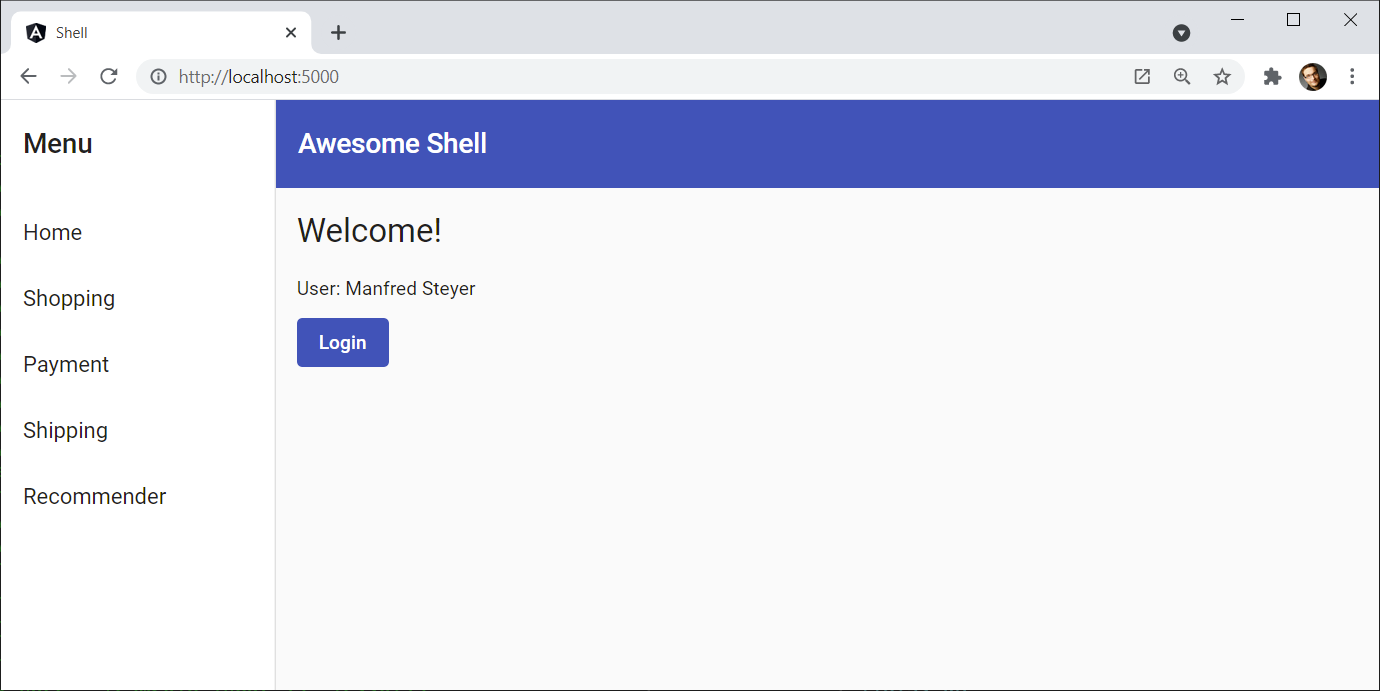
However, when loading the micro frontend on demand, it also knows about the current user:
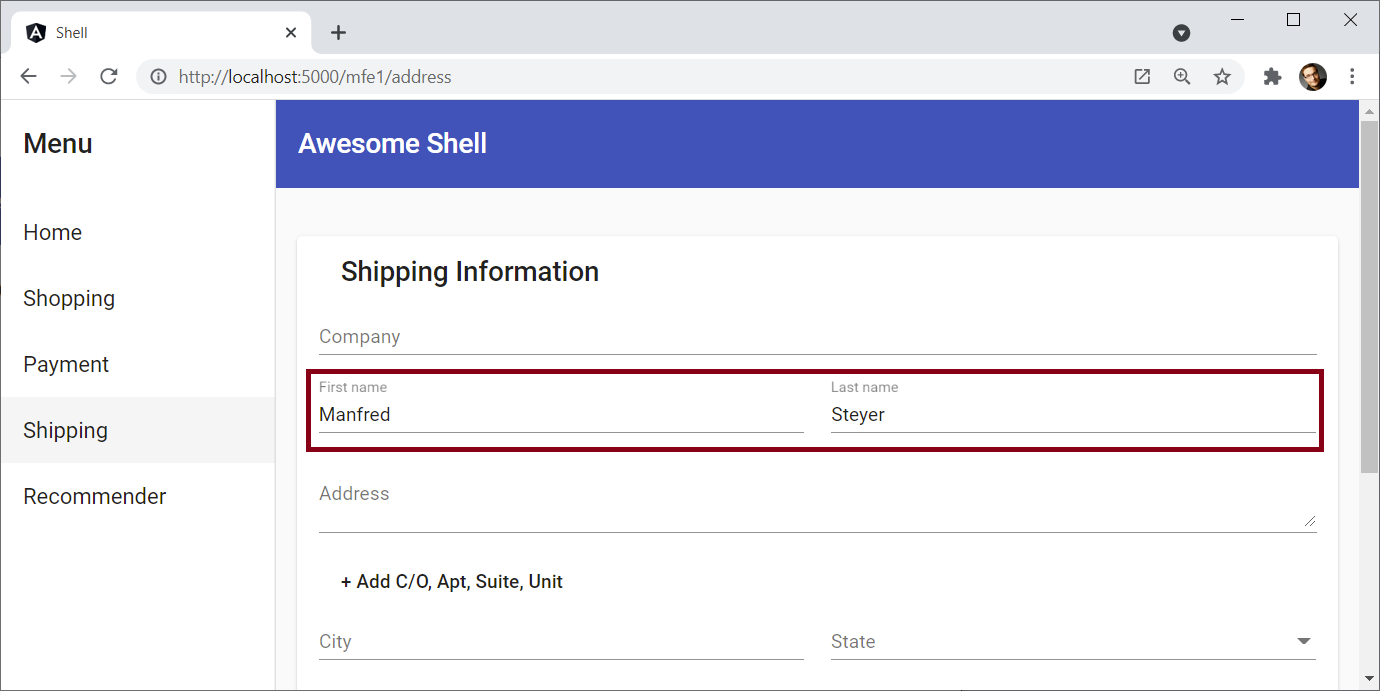
To achieve this, we just need to share a package that holds the information to share. In our case, this is
@auth0/auth0-angularnpm i @auth0/auth0-angular
To make this work, I've configured a web application at https://manage.auth0.com/. If you want to try this out, don't forget to register your SPA's URL, e. g. http://localhost:4200, under Allowed Callback URLs. Besides this, I went with the default values proposed by the web portal.
To get started, we need to import the
AuthModule@auth0/auth0-angularshellmfe1AppModule// projects/shell/src/app/app.module.ts // and // projects/mfe1/src/app/app.module.ts [...] import { AuthModule } from '@auth0/auth0-angular'; [...] @NgModule({ imports: [ AuthModule.forRoot({ domain: 'dev-ha-6vf7s.us.auth0.com', clientId: 'pQXuZGn3bfOfHpFd9ch7Wfa4xP4KhKlS' }), [...] ], [...] }) export class AppModule { }
The values for
domainclientIdAfter that, we can use the
AuthService// projects/shell/src/app/home/home.component.ts import { Component } from '@angular/core'; import { AuthService } from '@auth0/auth0-angular'; @Component({ selector: 'app-home', templateUrl: './home.component.html', styleUrls: ['./home.component.scss'] }) export class HomeComponent { user$ = this.auth.user$; constructor(private auth: AuthService) {} login(): void { this.auth.loginWithRedirect(); } }
I also decided to display the user's name after they logged in:
<!-- projects/shell/src/app/home/home.component.html --> <h1>Welcome!</h1> <p *ngIf="user$ | async as user"> User: {{user.name}} </p> <div> <button (click)="login()" mat-flat-button color="primary">Login</button> </div>
In the micro frontend's
AddressComponentAuthService// projects/mfe1/src/app/address/address.component.ts [...] import { AuthService } from '@auth0/auth0-angular'; @Component({ selector: 'app-address', templateUrl: './address.component.html', styleUrls: ['./address.component.scss'] }) export class AddressComponent { [...] constructor( private auth: AuthService, private fb: FormBuilder) { this.auth.user$.pipe(take(1)).subscribe(user => { if (!user) return; this.addressForm.controls['firstName'].setValue(user.given_name); this.addressForm.controls['lastName'].setValue(user.family_name); }); } [...] }
In order to make this work, we need to share the
@auth0/auth0-angular// projects/shell/webpack.config.js // AND // projects/mfe1/webpack.config.js [...] shared: share({ [...] // Add this: "@auth0/auth0-angular": { singleton: true, strictVersion: true, requiredVersion: 'auto' }, ...sharedMappings.getDescriptors() }) [...]
This ensures there is only one
AuthServiceAfter changing the webpack configuration, we need to restart our applications. If everything works well, we can log in the user via the shell and read the user's name in the lazy loaded micro frontend.
Summary
Module Federation allows loading separately compiled applications at runtime. Also, we can share common dependencies. This also allows sharing common data like information on the current user or global filters.
As Module Federation allows runtime integration, it is also the key for plugin systems and micro frontend architectures. However, this approach turns to compile-time dependencies into runtime dependencies; we need a sound set of integration tests to detect issues.
In general, Micro Frontends only makes sense if you want to scale a project by splitting it into several smaller applications developed by different autarkic teams. If you only have one frontend team, Micro Frontend architectures are very likely an overhead.
About the author

Manfred Steyer
Trainer and Consultant with focus on Angular
Under the leadership of Manfred Steyer, ANGULARarchitects.io supports companies with the implementation of web-based business applications with Angular.
At the Angular seminars he designs, he combined his profound knowledge of Angular, for which he was recognized by Google as a Google Development Expert (GDE), with his experience, which he worked as a team leader in the field of software development, as a Professor at a university of applied sciences and as an external member of the Angular team.
Manfred has published books at O'Reilly, Microsoft Press, and Hanser and writes for Heise Online, windows.developer, and the Java magazine. He also regularly shares his knowledge at conferences.
